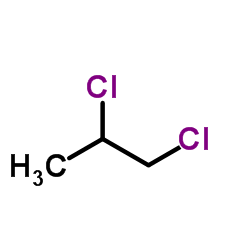1,2-Dichloropropane

1,2-Dichloropropane structure
|
Common Name | 1,2-Dichloropropane | ||
|---|---|---|---|---|
| CAS Number | 78-87-5 | Molecular Weight | 112.986 | |
| Density | 1.1±0.1 g/cm3 | Boiling Point | 94.5±8.0 °C at 760 mmHg | |
| Molecular Formula | C3H6Cl2 | Melting Point | −100 °C(lit.) | |
| MSDS | Chinese USA | Flash Point | 4.4±0.0 °C | |
| Symbol |


GHS02, GHS07 |
Signal Word | Danger | |
|
Cholangiocarcinoma among offset colour proof-printing workers exposed to 1,2-dichloropropane and/or dichloromethane.
Occup. Environ. Med. 70(7) , 508-10, (2013) The present study was conducted to investigate the relationship between occupational chemical exposure and incidence of cholangiocarcinoma among workers in the offset colour proof-printing section of a small printing company in Osaka, Japan.We identified 51 m... |
|
|
Inhalation exposure in Drosophila mutagenesis assays: experiments with aliphatic halogenated hydrocarbons, with emphasis on the genetic activity profile of 1,2-dichloroethane.
Mutat. Res. 252(1) , 17-33, (1991) A series of mutation experiments was carried out with Drosophila melanogaster using inhalation exposure. 1,2-Dichloroethane (DCE) and 1,2-dibromoethane (DBE) were active in the sex-linked recessive lethal assay (SLRLT), whereas dichloromethane, dibromomethane... |
|
|
Distribution of 1,3-dichloropropene and 1,2-dichloropropane in Big Creek watershed.
Bull. Environ. Contam. Toxicol. 47(4) , 572-9, (1991)
|
|
|
Experimental and theoretical studies on formation and degradation of chloro organic compounds.
Chemosphere 63(1) , 165-70, (2006) Studies on oxidation of tert-butyl ethers in the presence of chloride ions proved that acid medium favoured formation of chloro organic compounds. 1,2-Dichloro-2-methylpropane, 3-chloro-2-chloromethylpropene were identified among the reaction products. Presen... |
|
|
Fraction of electrons consumed in electron acceptor reduction and hydrogen thresholds as indicators of halorespiratory physiology.
Appl. Environ. Microbiol. 65(9) , 4049-56, (1999) Measurements of the hydrogen consumption threshold and the tracking of electrons transferred to the chlorinated electron acceptor (f(e)) reliably detected chlororespiratory physiology in both mixed cultures and pure cultures capable of using tetrachloroethene... |
|
|
Disposition and metabolism of [14C]1,2-dichloropropane following oral and inhalation exposure in Fischer 344 rats.
Toxicology 68(3) , 291-306, (1991) The objective of this study was to compare the disposition and metabolism of [14C]1,2-dichloropropane [( 14C]DCP) following oral and inhalation exposure since these two routes are of interest with regards to occupational and accidental exposure. [14C]DCP was ... |
|
|
Technological parameters of the ammonolysis of waste 1,2-dichloropropane.
J. Hazard. Mater. 106(2-3) , 107-14, (2004) The ammonolysis of waste 1,2-dichloropropane (DCP) using liquid ammonia has been investigated. The influence of temperature, molar ratio of NH3/1,2-dichloropropane and reaction time was examined. The highest yield of the synthesis was achieved at a temperatur... |
|
|
Inhalation carcinogenicity and toxicity of 1,2-dichloropropane in rats.
Inhal. Toxicol. 22(13) , 1116-26, (2010) The toxicity and carcinogenicity of 1,2-dichloropropane (DCP) were examined by inhalation exposure of male and female F344 rats to DCP for either 13 wk or 2 years. In the 13-wk study, the DCP concentrations used were 125, 250, 500, 1000, or 2000 ppm (v/v), an... |
|
|
In-vitro mechanisms of 1,2-dichloropropane nephrotoxicity using the renal cortical slice model.
Hum. Exp. Toxicol. 12(2) , 117-21, (1993) 1. Renal cortical slices isolated from the kidneys of male Wistar rats were used as an experimental model for studying the nephrotoxicity induced by 1,2-dichloropropane. 2. The solvent causes a depletion of renal reduced glutathione content and slight, but si... |
|
|
Mechanism of sex-related differences in nephrotoxicity of 1.2-dichloropropane in rats.
Ren. Fail. 17(5) , 517-24, (1995) The contribution of testosterone to the nephrotoxic effects of 1,2-dichloropropane (DCP) was assessed by a series of castration and sex hormone replacement experiments on Wistar rats. The nephrotoxic action of DCP was evaluated by measuring the accumulation o... |